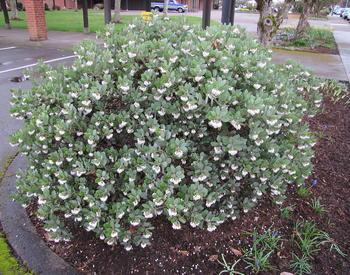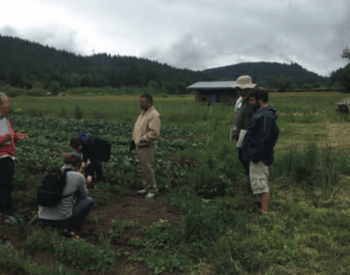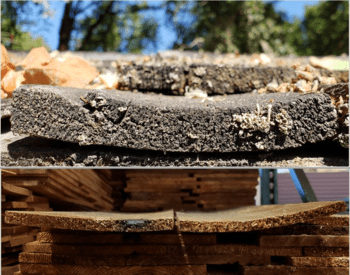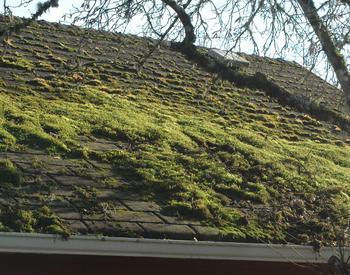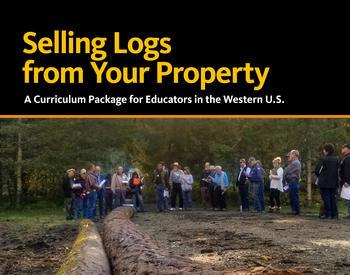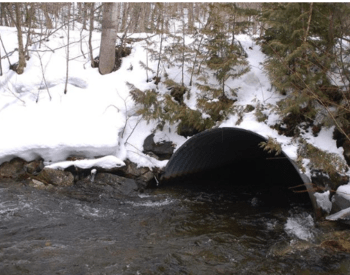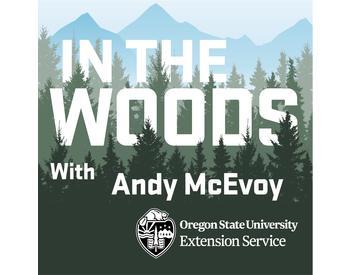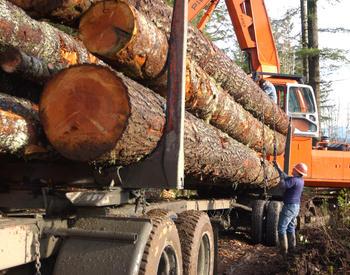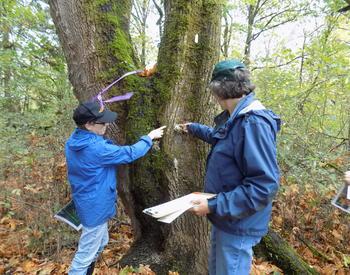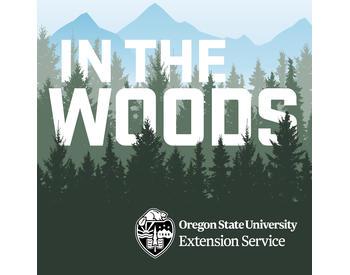Transcript
From the Oregon State University's extension service, you are listening to In the Woods with the Forestry and Natural Resources Program. This podcast aims to show the voices of researchers, land managers, and members of the public interested in telling the story of how woodlands provide more than just trees. They provide interconnectedness that is essential to your daily life. Stick around to discover a new topic related to forests on each episode. All right, welcome back everyone to the In the Woods podcast presented by the Forestry and Natural Resources Extension Program at Oregon State University. I'm Scott Leavengood, extension specialist in wood products, and I'm your host for today's episode on a very hot topic in forestry circles, mass timber. And I'm joined today by a couple colleagues from the TallWood Design Institute. Morning. Hey Scott. Morning gentlemen, please tell us a little bit more about yourselves and the TallWood Design Institute, and to simplify things a little bit from here on out I'm simply going to call it TDI. Let's start with you Iain. Hi there, my name is Iain Macdonald I'm the director of the TallWood Design Institute and I've been in Oregon about five years which roughly corresponds with the time that TDI has been around. And my name is Evan Schmidt, I'm the outreach and education manager at TallWood Design Institute. I came to Corvallis in 2016, I received my master's in wood science in 2018 and I've been working for TDI ever since. Great, give us a little bit of background here on TDI. When was it founded? Who's involved? And so forth. Yeah, so TDI has been around since about 2016, 2015 um, we got our name in 2016, but really we're a collaboration between the college of forestry and the college of engineering at Oregon State University and the college of design at University of Oregon. So, we're a weird collaboration between the beavers and the ducks um but the idea is to try and work across the disciplines of forestry, wood science, engineering and architecture to do applied research to applied education and really try and create more economic benefit from our forests using kind of a new breed of engineered wood products. Great, well I was thinking that being a couple of universities that's focused primarily on the research community but it sounds like from what you said there at work you work also with the users of the mass timber, right? Yeah, very much so you know the the state um when they funded us in 2015 I think for the first time um really we're looking at economic development outcomes for Oregon. So, you know if you think of the jobs that have been lost in the timber industry since the 1980s when a lot of the federal forests had curtailment of harvest you know what we're trying to do is kind of bring those jobs back in new manufacturing enterprises. You know, using the lumber that's already produced and the veneers already produced mass timber which we'll talk about I guess uh in a few minutes. So, we do we do applied research we do testing we work closely with companies who are interested in testing new products and we work closely with you know developers and architects who might want to get a design certified for a new building but you know they need some independent testing in order to get a permit for that building, so wide range of different things. Right, right yeah and like you said here and that like so often happens when talking with experts and people passionate about their areas of work we just launched right in but we probably should take a step back and define our terms. What is mass timber? Yeah, I can take a stab at that. When people think about mass timber, a lot of times they think CLT which stands for cross-laminated timber, I'd say it's sort of the poster child of the mass timber movement, and CLT is basically just giant panels of wood made up of layers of dimensional lumber usually two by six and it's glued together in layers of 90 degrees. But really just taking a kind of a more basic approach, mass timbers are massive timbers. They're basically just large structural wood elements used in larger buildings. So, instead of using a two by six by eight foot piece of dimension lumber from home depot, you're using a glulam beam that's two feet deep and 20 feet long and made up of many pieces of dimension lumber. Or instead of using a four by eight sheet of plywood you have a ten foot wide by forty foot long by six inch thick mass plywood panel made up of many sheets of plywood. So, these products are significant because they're so much larger in scale than traditional wood products they can now replace reinforced concrete or structural steel in many applications and in larger buildings, so that's really the significance there and I guess one way to think about it is you know instead of instead of a bunch of two by sixes making up a floor of a building you can think about it as an entire floor of an apartment might be made up of one or two pieces of mass timber. Wow. I guess what's also important to remember is that mass timber defines both a range of large engineered wood products as well as a type of building construction. And that's typically defined by at least having a significant portion of the building structure made up of mass timber elements. Great, yeah, well thank you for that Evan I've heard these products often referred to as engineered wood products, what's what's meant by that term? Right, uh so wood as a material fluctuates a lot in terms of its properties, whether it's from species to species, or from tree to tree, or even what part of the tree the wood was cut from. You know, there can be knots, slope of grain, differences in density, and all sorts of things that affect how strong one piece of wood is compared to another. Simply put wood is not all created equal and to complicate matters a little bit further wood coming out from let's say uh forestry plantations or wood coming out from forests that were harvested to thin for restoration projects can be of a lower quality potentially than what might have been harvested from older trees, so we have to figure out how to build strong materials from a material that might not be perfect. So, an engineered wood product takes all this variable wood material, breaks it up into smaller pieces, and then randomly reassembles it into a final product that is far more predictable uh than a natural piece of wood might be. It's kind of like shuffling a card deck you randomize things and it creates a more even game. So, you can think about how plywood is made for many sheets of veneers that are glued together or oriented strand board, known as OSB, there's a lot of flakes that have been glued together into a panel. And in effect what's going on is those defects are getting distributed through the material more evenly, so you can significantly shrink the range of variability and performance. So, even if you're using worse wood to start with you can have a higher performance since the overall behavior is more predictable it's really the important thing. So, anyways, back to mass timber, you can think of mass timbers as gigantic engineered wood products except in this case the small pieces, and I'm doing air quotes here small pieces, that are glued together are now entire 2x6 boards or entire sheets of plywood. And the end products are giant panels with again these sort of predictable qualities. All right, that's good, yeah, it's good to know about the predictable qualities of these things that are holding up tall structures. Sounds like what we're talking about here is a real innovation in wood products. So, what was the inspiration for CLT and mass plywood? I know they're both made in Oregon. Were they invented here, Iain? No, actually CLT was invented in Austria in about the mid 1990s, and it's interesting actually it wasn't it's really conceived of nowadays as a very sustainable product and that's one of the drivers for its use, but originally the um sawmills in Europe were looking for a place to use the side lumber, kind of the lumber that fell off that wasn't much use for anything, and they you know they began to engineer these panels and this was something that originated in the University of Graz actually in Austria. So, university project, um the first manufacturers of mass timber started in in Austria actually around 1995. It became popular and then in 2000 and about 2009 um British Columbia, Canada, started to take an interest in this. They uh you know forest industry similar to Oregon very very important to the provincial economy um and they uh put some government effort behind trying to promote these materials and so we saw the first buildings in North America really sort of happened there. And then you know things kind of migrated down the I5 corridor I guess to Washington and Oregon and Oregon really became kind of like the first mover in the United States in terms of these design and manufacturing technologies, so we had the first manufacturer of the first certified manufacturer of CLT for use in buildings, um D.R. Johnson in Douglas County, Riddle, Oregon, got going around 2016. And that was due to some work with the wood science and engineering department at OSU actually who worked with them on their products and helped you know test it before they went for their certification. Then a couple years later, uh researchers in the same department with science and engineering uh started to work with Freres, a lumber company who are a plywood manufacturer in the Stayton Valley, the Santiam Canyon I should say, and they invented a whole new category of mass timber panel called a mass ply panel. And that's the one that Evan already talked about where they've taken the veneer layers and they're building these massive thick panels that can be three, four or five inches thick. So, uh you know we've found that uh Oregon kind of took the ball and ran with it in terms of mass timber um became the first state to do a bunch of things you know to uh endorse new code provisions for mass timber and all kinds of things, so now we're finding that we've got designers and architects, engineers and construction firms who are kind of fanning out across the country doing this work, which is really exciting. That is exciting, yeah, so so designers it sounds like uh are excited to work with this new material, huh? Yeah, exactly I mean I think they see a bunch of benefits maybe kind of run through a few of those, you know, firstly, as Evan said you know the the sheer size of these panels and beams allows wood to be used in applications that used to be kind of the exclusive domain of concrete or steel. So, you know we didn't used to be able to build very very tall or very large with wood. Um you know there's good reasons for that you know 100 years ago um we didn't have uh good fire suppression methods, we were you know we had um we didn't have the the kind of modern zoning and code provisions, and so fire and things like that were obviously concerns and now we have good um data that says that mass timber can perform pretty well in fires um in combination with uh you know sprinkler systems and a whole bunch of other things. But you know in terms of benefits so wood can be used in these bigger buildings, taller buildings that gets designers and policy makers interested because mass timber is generally more sustainable than concrete or steel and we often talk about a thing called embodied energy and that's the amount of energy that's required to produce the materials that are used in the in the construction process. So, you think of what's required for steel you know energy goes into forging steel you look at concrete and the the energy required to produce cement. Wood has a much much lower embodied energy you know essentially the material grows from solar energy, and then there's some processing that happens in sawmills you know like but uh that um embodied energy means that you know it's a more carbon friendly more um um you know environmentally friendly material than than concrete or steel. Um and then that there's other benefits you know because these panels can be very very large, construction can happen very very quickly. Um so once you've produced these panels in a factory, you can use a what we call a CNC machine, computer numerical control, so that's a machine that uses a three-dimensional cad drawing to create all the tool pads and and digitally fabricate the panel for a particular place in a building so it can cut out window openings and door openings and channels for electrical and plumbing and all of that and even kind of pre-drill you know holes for connectors to be applied, so when you get onto the job site the construction can take place much quicker. First of all, you've got bigger elements and second a lot of the prefabrication's been done. So, you've got lower labor costs on the job site that's an issue and that's an advantage because um we do have labor shortages in the construction industry a lot you know up and down the west coast. And then you have other things you know um the project the the construction phase itself is quicker so you have lower insurance costs for the developer, you have you know less time required to rent scaffolding and cranes and all the other expensive equipment. And then for the surround people in the surrounding environment you have fewer deliveries to site you don't have all these concrete trucks rolling up, so the job site is less congested, it's cleaner, it's quieter, it's uh less people on site so it's inherently safer. And then for designers you know it's wood is an aesthetically pleasing and healthy um and inspiring material that they love to work with. Um and so you know they having this new pallet of materials is really exciting for designers too. And I think you know thinking about Oregonians you know there's a love of the outdoors in nature and there's a uh you know kind of an affinity with the state's timber industry route so all of those things fit really well with with mass timber. Definitely that's... Go ahead Evan, sorry. Oh, yeah, sorry I was just going to add on that a little bit um you know there are a number of really interesting environmental considerations and benefits to mass timber I would say that are getting the design community particularly interested in mass timber and it's been really interesting because it's been really creating an engaged architectural community in the realm of forestry. So, one one area that I think is really intriguing is the connection between again restoration forestry and the byproducts that come out of it that are often small diameter trees um they can be of lesser quality or less predictable qualities uh so you know taking these by-products and being able to put it back into a large engineered wood product creates an economic outlet for uh these forestry activities. So, there's been a lot of excitement generated on on that front as well. Yeah, wow, that's uh amazing uh long list of advantages there. What about any downsides, gentlemen? Well, of course, with any material there are downsides and I think you know probably one of the biggest you know it's not specific to the material, but this is a new thing, and so designers, permit officials, insurance firms, construction firms are not as familiar with this. You know, they're getting into it for the first time and whenever you do that there's a little bit of trepidation around what's going to happen and so there can be added costs you know sometimes costs are added along the supply chain because people are hedging against any uncertainty. It's perceived for that reason as being a little bit more expensive material although we're finding you know as developers and designers and and construction firms start to get experience with with this kind of building, they're able to uh pencil against concrete or steel um you know quite often and in some cases save money over the cost of you know building something with concrete or steel. And what I'd say is you know to really optimize those costs um the different professionals need to start talking earlier in the in the construction and design process, so rather than being this kind of passed along the chain kind of approach which typically happens in a construction project. Um they need to kind of get together and and talk from the beginning you know that the fabricators of the material, the the mass timber manufacturer needs to be sitting in the room with the the architect and developer and the contractor you know from kind of day one. Evan you probably have other things you want to add to that, right? Um, yeah, I mean I guess I would just say uh kind of iterate what you've been saying is that the the overall downside seems to come down to perceptions of additional work and and risk. And I would say it's sort of a chicken and egg kind of scenario over the last half decade where you need manufacturers to invest in producing the stuff to bring costs down uh, but you also need owners and architects and the people that are specifying mass timber to create demand for those manufacturers to make it. But we have been seeing over the years you know something like a twofold uh growth in the industry every year um so it seems to be happening but yeah back to risk it seems like many designers people in general are just more comfortable with using conventional materials that we've been using when it comes to larger buildings, so that's concrete, steel and so it takes a willingness to want to learn and really grow to embrace this new type of construction. Well speaking of these conventional materials steel and concrete, um. Is there some interplay here between these and CLT? Yeah, um, steel and concrete are amazing materials, so we're not here to deny that or um downplay that. I think what we're here to say is that every material has its right place, and actually oftentimes buildings are built as hybrids of materials, right? It's pretty rare to see a building made exclusively of one kind of primary material, so. An example of how timber interfaces with these materials it's very common um is cross-laminated timber panels or mass plywood and concrete often go together in floors. So, we call these a timber concrete composite floor, so you put a concrete topping on top of the wood and this has all sorts of benefits um it increases the spans, it adds stiffness to the system, dampens vibration, and adds thermal mass to the system. So, there are definite benefits to hybrid systems. Okay, very interesting I think people often think that it's pure competition here, but it sounds like they they can work and play well together in some cases right, yeah? So, what about species um we have Douglas fir as our state tree of Oregon it's long been our dominant species used for structural lumber and plywood. Is Douglas for also leading the way in mass timber? Yeah, you know Douglas fir is a great species it's strong and stiff it's used by our mass timber manufacturers here in Oregon. That said around the country and in Canada and other other places um we're seeing different species being used that are kind of more regionally specific. So, you know we have southern yellow pine being used down in the south, um. We have um you know SPF uh spruce pine fir mix being used in other places. In uh northern Washington and Canada I believe there's some use of hemlock, so that's kind of you know we think about ponderosa pine here in Oregon as a western youth wise species we'd like to use more of. It's kind of similar for hemlock in uh you know northern Washington and B.C. so and then in Quebec you know one of the oldest North American manufacturers uses black spruce um way up and they're kind of close to the boreal forest, so it really depends on what what's available and of course all these products have to go to kind of a rigorous certification process with testing but um you know we're finding that the number of species being used is kind of growing all the time. Yeah, that certainly sounds like a pretty wide range of species already. Are there other species that are being explored? I can take that um, yeah, there's there's interest in other species you know for economic and environmental reasons. An interesting example would be you know in Europe they're increasingly looking at hardwoods over soft woods and more specifically beech uh since you know they're predicting that soft wood habitat is going to shrink along with climate change and global warming. Over in our neck of the woods there's interest in ponderosa pine like Iain was saying and white fir, for example, because they represent you know common species and large swaths of forests that are climate stressed and under burned historically, so, forests that need attention and restoration work uh done to them to keep them healthy. If we could use wood from those forests and these engineered wood products, then there are a few wins. You know, we can mitigate that wildfire risk and sequester carbon at the same time. And then of course like I mentioned earlier we'd be creating an economic outlet to actually pay for that restoration place in the first place, excuse me. Yeah, interesting, the um, shifting gears are a little bit, what about dimensions and lumber grades? Uh does mass timber require the very best the top grades of lumber and veneer? Uh we touched on this a little bit earlier, but yes and no. Uh the standards that define how these products are made specify grade. For example, the standard that defines how you have to make and test CLT, that's the PRG-320, says you have to use a certain grade for the outer layers where the most stress occurs and then you can use a lower grade for the interior, but these aren't the top grades of lumber. Different CLT species are going to have different design values because of wood variability. Like Iain was saying back to Doug fir is kind of a premier soft wood, um, but you know it differs between products glulam is another example where you can specify various layouts and grades, for instance, in the outer layers uh that's where you're getting the most stress you can you can basically specify custom layouts, so. Okay, customizing. So, uh gentlemen what sort of research are you doing now at TDI? And what do you see on the horizon? Well, there's a lot of research going on you know I said earlier that we were created to try and promote interdisciplinary collaboration, we have a lot of that going on but you know the research really runs the gamut from structural testing you know for you know structural and seismic performance to work on wood durability, you know, for example, we've got projects looking at what's the impact of moisture and wet wetting during construction on the strength of connectors used in mass timber? You know, acoustics is really important area we have if you're using steel and concrete, this is true of a lot of a lot of data in mass timber just because it's so new, we don't have enough data for designers to be able to evaluate you know what kind of floor system should I build up here? What kind of wall system? How do I connect my walls to my floors? So, you know there's a wealth of information for steel and concrete that have been used in these last buildings for these large buildings for 100 years. But with with mass timber we're kind of starting from not exactly from scratch, but you know we just don't have the the breadth of data, so a lot of it is just trying to do the the testing provide uh values for you know acoustic properties um fire resilience and all of that. Another area that's really uh hot topic is life cycle analysis and carbon impacts you know we know that you know that mass timber is sustainable, but how sustainable is it really, you know? If you're buying a mass timber product so it's it's wood and it's got less embodied energy than steel or concrete, but then you're shipping it from Austria to the west coast of the U.S. Is that really more sustainable in the long run? You know, probably not. So, a lot of things are centering on you know what is the big picture in terms of the the environmental impact of these products um and that kind of crosses over into designers being increasingly interested in forest management methods, you know. Where am I getting my wood from? What's the the chain of custody from um you know from the forest through the mill to um the mass timber mill and to my building? And um you know does it you know there's a lot of misconceptions around does something have to be certified timber to be sustainable? You know our feeling is no but you really have to look hard at every every source of wood and where that comes from and how that's being managed. So, that's a that's a big topic. I'll just say one of the things that we've done this last this past year that's quite exciting at TDI is we created this research consortium with 17 companies who are structural engineers, architects, construction firms, manufacturers and they're they're pulling their money to do a whole bunch of testing that will kind of help you know elevate mass timber um in terms of how it performs and the data we have that we can take to building permitting officials and so on so it's really a wide range of research going on. Yeah. Yeah, and I might I might tack onto that just to do a plug for uh the lab that we work in our lab, so um the college of forestry here at Oregon State University uh built two new buildings uh within the last few years including the A.A. Red Emmerson Advanced Wood Products Lab, and that's where TDI is headquartered and part of that lab has got a very large strong floor and strong wall system, so it's a structural testing lab, and arguably probably the largest in the country dedicated strictly to timber engineering. So, right now we have a full three-story timber structure erected inside of our lab that we're going to be testing soon for seismic purposes. Three stories, wow. So, uh years ago when I first started hearing about these products the big questions are related to fire and earthquake and you've touched on fire a couple of times. Are there concerns for earthquake performance as well? Yeah, so I'm going to um I get this question a lot and I'm going to get like kind of kind of weird about it so think about trees. They're basically like cantilever beams sticking out of the earth with massive sails on top made out of foliage, right? And that's actually why wood is so strong in bending is because trees sway and bend in a storm some break and die and the ones that don't survive to pass on a new generation of stronger trees. So, this is natural selection for strong wood. Yeah. So, nature and effect has provided us with this material that's designed to weather strong forces and seismic performance is one of these arenas that many folks agree wood actually really excels at. It's not only strong it's it's also important to emphasize that wood is relatively light as well so we say it has an excellent uh strength to weight ratio, again doing air quotes there, and that's good for earthquakes because less mass in the building is generally ideal. Of course, that depends on how and where it's located uh just kind of as an aside you know traditional Japanese architecture mastered certain forms of seismically resilient timber structures just by properly considering how the wood connections work and where that mass is distributed. Anyways, another factor, this is kind of interesting that makes wood ideal, is how well it responds to dynamic loads, so that's um loads that come on really quickly and strongly instead of you know long persistent loads like just gravity like weight. Um so you know this this comes back to forest you can think about bursts of wind hitting a grove of trees. It's a lot of load all of a sudden that eventually goes away pretty quickly um wood takes that shock really well that's actually one of the reasons CLT's performed well in blast tests that have been done so that's kind of just another interesting aside. So, anyways, in the end seismic performance really just boils down to the members and the connections it's really a system-based thing but what is just as good as any material for earthquakes. Very interesting, yeah, I'm going to take that away as the I had never thought about a tree as a cantilevered beam, so you know great for performance and earthquakes, but what about fires? You said what is the research shown there? Yeah, Iain touched on this a little bit but fire is a really big topic as you could likely understand in the timber building world. And there's actually a really interesting history surrounding mass timber in the U.S. involving the International Code Council of the ICC, they basically write the international building code, and a committee that they set up years ago to investigate mass timber. Particularly considering fire that was one of the main things they really wanted to look into. And the small and short of it is that there were numerous large-scale uh so-called compartment fire tests that were set up so what that is is entire furnished apartments we're talking multiple full-scale apartments were built. And they include furniture, books, you name it. Anything that would be a real um fuel load in real life in a real apartment. And then they set them on fire. So, some of these apartments had gypsum board in them some didn't some had sprinklers some didn't and the results overall shocked the committee it was a committee of fire marshals and engineers and at least one architect that I can think of because the the apartments performed so well. The wood basically seemed to self-extinguish after the primary fire consumed all the fuel in the apartment and even lit the wood surfaces on fire. So anyways in the end these tests along with um some other tests they put on and they did a global literature review were the basis for the ICC, that's International Code Council again, adopting mass timber into the building code. So, that's why we can now build up to 18 stories in timber whereas previously it was limited to something like six stories. I guess just to kind of emphasize why mass timber is different or why that's the case. If we just kind of think back to the fundamentals, fire needs oxygen to combust. Otherwise, it just is smoldering. Large wooden members actually insulate themselves from fire with the char layer that develops as they burn and they smolder at a very predictable rate. Even with a fire raging nearby, engineers can predict how long it takes for wood to burn through its cross-section as it's smoldering and engineers have been designing glulams for for many decades under those principles now. So, you know thinking about it intuitively the average person knows you need kindling and small pieces of wood to get a fire going and even a really big log and a raging fire is going to take hours to burn down and you really need lots of supplemental fuel to keep it from just simply smoldering. So, anyways back to the research side, I would argue that the research is sort of beyond the basic question of whether mass timber can meet basic fire safety in ratings and it's moved a little bit more onto improving resins for fire performance, testing new species and assemblies, uh, and in particular contributing to the realm of performance-based design where we can get beyond the sort of standards of one and two and three-hour fire ratings and actually get into fundamental fire dynamics as a basis for design, but that's a whole other topic, so. Yeah, right, well that's it certainly sounds like fantastic news for safety and some of the biggest things that people are concerned about um I think Iain touched on this a little bit, what about durability, longevity? How long are these mass timber structures expected to last? Uh well I mentioned old Japanese timber structures um you know some of our oldest buildings are timber buildings, and really boils down to proper design maintenance like with any building. Probably even more so it boils down to culture and how long buildings last on what the culture attributes to their value, and the need for the building, and the ownership, changing land values. It's often the case that buildings are torn down before their lifespan is even up, so, that's that's one major factor. I guess the important takeaways, any material including concrete is susceptible to the environment particularly moisture and fire. Concrete ages, it cracks, and it's got to be replaced and repaired the same as wood. Steel for example is very susceptible to fire and has to be protected oftentimes with intumescent paint fire retardants that expand. And in some cases, steel is actually protected with wood which is often the case in mass timber buildings where the steel connections are concealed behind the mass timber elements so it's pretty crazy. Yeah, there's an interesting idea using wood to protect steel from fire. Okay, well for uh one final question for you guys, let's get back to to being in the woods here. How do you think mass timber might impact Oregon forest and our forest land owners. Well, I think mass timber has been great in uniting stakeholders um you know we have architects you know talking to manufacturers and uh you know woodland owners in ways that they you know never made those connections in the past. Um you know there's a knock-on supply chain effect to any you know this increased demand for mass timber, so as we start to build more with that there's of course increased demand for lumber, plywood, veneers which go into those project products. And so we're starting to replace some of the jobs that were lost as I as I mentioned at the beginning you know um over the last what 30, 40 years in the timber industry um I think that designers are seeing uh much more paying much more attention to sourcing. Where the wood comes from?, um, how are those forests managed?, where that wood is is sourced? And so that is uh great news for woodland owners who are sustainably managing their their small forests. You know we have a project right now that is a very ambitious undertaking TDI is part of something called the Oregon Mass Timber Coalition and we're working with various agencies Business Oregon, the Department of Land Conservation and Development, Oregon Department of Forestry and the port of Portland on a big undertaking where we would establish a modular housing factory using mass timber from Oregon and produce small affordable housing modules at scale where we can tackle kind of simultaneously you know the affordable housing crisis that's affecting a large part of Oregon as well as reducing wildfire risk by sourcing more of the fiber from forestry restoration work. And then you know creating those jobs all along the supply chain from from the woodlands through to the sawmills, the mass timber manufacturing facilities, and then the modular housing factory itself and in construction. So I think you know we're trying to create these synergistic benefits and you know and as well you know do good for the environment by reducing the the greenhouse gas you know the the um the carbon footprint of our built environment, um, Evan I'm going to let you have the last word, though. Yeah, yeah, sure I mean so at risk of repeating a few things that Iain said, I guess I would say what's really amazing about mass timber is that it has captured the hearts and minds of a really wide audience, and I would argue has rejuvenated the question of our forest and forest products in the public eye. People are are more open to wood products now um and they're increasingly seen as a potentially major solution to climate change. Uh and you know through a more nuanced lens than forestry is bad or forestry is good uh it's creating connections between industries that have been traditionally siloed, like Iain said, architects, engineers, builders, are all of a sudden interested in forest practices and what different certifications mean. States and counties are interested in the potential use of again these restoration byproducts and engineered wood products to mitigate wildfire risks. People are becoming increasingly aware of the fact that people are happier and respond well the wood in the built environment. People like being in wood buildings, so ultimately you know there's this connection forming in people's minds between the stewardship of our forests and our natural environments and our built environment, which is really cool. I would argue that the impact goes beyond just increased demand for wood from our forests, a lot of people kind of go straight to that. I would say it really means mass timber is becoming a mechanism for deepening our collective connection to the forest and forest management. Um there's a really large net of people that believe that proper forest management building with wood can again be this major part of our tool kit in fighting climate change, and they they want to play a more active role in that conversation to make sure it's done right. I think that cultural shift will bring additional spotlight to our forest so it'll become you know our forest will become more culturally centered again. You know there's going to be increasing pride in forestry and wood products and I think on the flip side there's going to be increasing pressure to improve our forestry practices over time to reflect these evolving values and and the science that's emerging out of our college. Wow, that's fantastic gentlemen and yeah very true I think we're certainly seeing how mass timber is bringing together professions that really haven't traditionally worked together and like like you both said earlier this wood renaissance links uh forest reconstruction, interior design even and like you said just now the linkage to force and forestry just might warrant its very own podcast episode, we'll see. Okay, gentlemen, before we wrap up this episode I have a few more questions for you in what we call the lightning round (Music Playing) So, the first question, what is your favorite tree species? We'll start with you Iain. Well, you know I have to stay true to my Scottish roots and say the Douglas fir you know named after uh David Douglas, Scottish botanist, and you know so important to Oregon as well. Yeah, turns out to be on our license plate I believe and state tree as well, yeah, good choice. Uh Evan that leaves it to you now. Well, now i feel like a trader because I was gonna say the California live oak or the the coast live oak, but I grew up down in California so I'm a big fan of the oak savannah with those those big evergreen oaks, so it's probably where I'd go. All right, all right, probably not a lot of relevance there for mass timber for Evan, but certainly for Iain, right? At least not yet. Yeah, live oak CLT would be pretty heavy wouldn't it.
So, how about question two then, what's a unique tool that you use that helps you with your work? We'll start with you this time Evan. Uh cattle prod? Uh, no, I'm just kidding um you know most of my work's on the computer, so that's not the most unique tool, but uh you know maybe in a more abstract sense maybe uh humor is kind of its own tool for keeping work fun and you know building relationships. Yeah, yeah, relationships are important in the industry, yeah. How about you Iain? Unique tool? Yeah, well I'm kind of like Evan um you know we have a lot of talented people on our team at TDI who can do technical marvels with uh equipment fabrication testing, but I'm not one of those guys um I'm a pencil pusher and uh I'm a laptop uh puncher, or whatever, so um yeah probably the most important tool for me would be uh several cups of tea a day to keep the you know keep the creative juices flowing I guess. Fair enough, okay, lastly we're moving through these pretty quickly. What other resources can you share related to mass timber for any of our listeners that would like to dive deeper into the subject? Uh Iain. Yeah, well you know we have an interesting resource that we started a few years ago called the critical mass timber meetup group and it's uh it's meant to be a way for um industry to network with um our university community working on research and you know stay abreast of uh some of the things that we're doing and the impacts for the industry and you know just a way to share information and lessons learned and um you know that community has grown and since we kind of took it online in the in the early days with the pandemic we have close to a thousand people um signed up to that group and we have monthly events that Evan is uh is uh curating and um you know some great discussions around all kinds of topics related to mass timber so I'd really encourage people to go to meetup.com and look for critical mass timber meetup. That's that's my one. interesting resource, we got a theme developing here on the importance of relationships, so. Evan you get to have the final word here other resources. Um yeah, no I definitely agree with Iain, the critical mass timber meetup's a great starting point it's free. Um if you're interested in diving into it a little deeper and maybe kind of moderately formally we also have been building out a certificate program that has modules that you can take individually, so for instance we've got a module that's specifically an introduction to mass timber products, manufacturing, and building systems. Um, so, if you kind of want to take like a little bit more of a deep dive that'd be a good place to start as well, so, yeah. Of course, like the internet is a rich with opportunities so there's lots of articles out there if you're just trying to kind of learn a little bit informally. Yeah, tons of stuff especially as hot a topic as as mass timber is nowadays. I was thinking your TallWood Design Institute website as well if I remember right you have this uh virtual institute tour there is that right? Um, yeah, we actually we have a scan a 3D scan of our labs, so um it's actually pretty cool you can kind of like navigate like a ghost to the lab and look at the different equipment and learn a little bit about it so we'll make sure to share those links with you guys. Sounds good I know people are always asking to have tours of the facilities here especially the one you guys are in the the newest and highest tech, so yeah make sure people get a chance to take that tour whether they're in Corvallis or not. So, that's it Iain, Evan, really great to have you you both today mass timber is again certainly a really hot topic, I'm glad we had this opportunity to pick your brains a bit uh and I will allow you each to say farewell. All right, well, thanks Scott, great being here. All right. Thanks for having us Scott it was great. My pleasure. Well this concludes another episode of OSU forestry and natural resource extension's In the Woods podcast series. Thank you all so much for listening don't forget to subscribe bye bye all.
Thank you so much for listening show notes with links mentioned on each episode are available on our website in thewoodspodcast.com. We would love to hear from you, visit the tell us what you think tab on our website to leave us a comment, suggest a guest or topic, or ask a question that can be featured in a future episode. And also, give us your feedback by filling out our survey. In the Woods was created by Lauren Grand, Jacob Putney, Carrie Berger, Jason O'Brien and Stephen Fitzgerald who are all members of the Oregon State University Forestry and Natural Resources Extension team. Episodes are edited and produced by Kellan Soriano. Music for In the Woods was composed by Jeffrey Hino and graphic design was created by Christina Friehauf. We hope you enjoyed the episode and we can't wait to talk to you again next month. Until then, what's in your woods?
In this episode, Scott Leavengood is joined by Iain Macdonald and Evan Schmidt to discuss how mass timber could play a role in solving climate change. Iain Macdonald is the director of the TallWood Design Institute and Evan Schmidt is the outreach and education manager.
